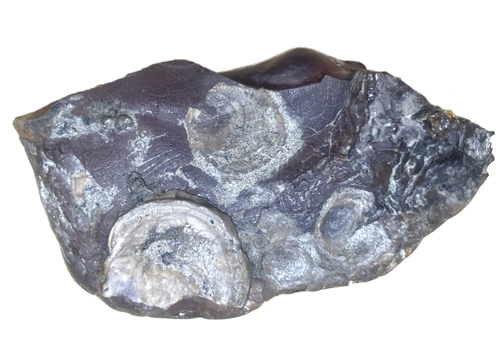Abstract
The mid-Cretaceous Burmese amber was extensively colonized by marine epibiont communities, including pholadids, corals, oysters, and serpulids. In this study, we report a diverse array of marine organisms that adhered to the amber, forming epibiont communities. Notably, cheilostome bryozoans are documented for the first time as an additional group of colonizing organisms on Burmese amber. These bryozoans formed extensive sheets and proliferated on the amber surface, often encrusting other epilithic taxa such as serpulids and oysters. The encrusting organisms exhibited significant marginal competitive interactions, including overgrowth and stand-off behaviours, as they competed for space. These hard substrate communities display trends similar to those observed in extensive soft substrate communities, resembling many counterparts in both modern and geological records. This discovery provides valuable insights into the composition of epibionts, the sequence of their colonization, and their ecological interactions on Burmese amber. Furthermore, this study indicates that the establishment of epibiont communities on Burmese amber occurred later than the entrapment of bioinclusions but earlier than the deposition of nearshore gravel strata.
References
- Ager, D.V. (1961) The epifauna of a Devonian spiriferid. Quarterly Journal of the Geological Society, 117, 1–10. https://doi.org/10.1144/gsjgs.117.1.0001
- Aitken, A.E. & Risk, M.J. (1988) Biotic interactions revealed by macroborings in Arctic bivalve molluscs. Lethaia, 21, 339–350. https://doi.org/10.1111/j.1502-3931.1988.tb01762.x
- Alexander, R.R. & Scharpf, C.D. (1990) Epizoans on late Ordovician brachiopods from southeastern Indiana. Historical Biology, 4, 179–202. https://doi.org/10.1080/08912969009386542
- Alvarez, F. & Taylor, P.D. (1987) Epizoan ecology and interactions in the Devonian of Spain. Palaeogeography, Palaeoclimatology, Palaeoecology, 61, 17–31. https://doi.org/10.1016/0031-0182(87)90039-3
- Barnes, D.K.A. (1994) Communities of epibiota on two erect species of Antarctic Bryozoa. Journal of the Marine Biological Association of the United Kingdom, 74, 863–872. https://doi.org/10.1017/S002531540009010X
- Barnes, D.K.A., Rothery, P. & Clarke, A. (1996) Colonisation and development in encrusting communities from the Antarctic intertidal and sublittoral. Journal of Experimental Marine Biology and Ecology, 196, 251–265. https://doi.org/10.1016/0022-0981(95)00132-8
- Barnes, D.K.A. & Dick, M.H. (2000a) Overgrowth competition in encrusting bryozoan assemblages of the intertidal and infralittoral zones of Alaska. Marine Biology, 136, 813–822. https://doi.org/10.1007/s002270000253
- Barnes, D.K.A. & Dick, M.H. (2000b) Overgrowth competition between clades: implications for interpretation of the fossil record and overgrowth indices. Biological Bulletin, 199, 85–94. https://doi.org/10.2307/1542710
- Barnes, D.K.A. & Lehane, C. (2001) Competition, mortality and diversity in South Atlantic coastal boulder communities. Polar Biology, 24, 200–208. https://doi.org/10.1007/s003000000196
- Breitburg, D.L. (1985) Development of a subtidal epibenthic community: factors affecting species composition and the mechanisms of succession. Oecologia, 65, 173–184. https://doi.org/10.1007/BF00379215
- Devescovi, M. (2009) Biometric differences between date mussels Lithophaga lithophaga colonizing artificial and natural structures. Acta Adriatica, 50 (2), 129–138.
- De Gibert, J.M., Domènech, R. & Martinell, J. (2012) Rocky shorelines. Developments in Sedimentology, 64, 441–462. https://doi.org/10.1016/B978-0-444-53813-0.00015-0
- Furlong, C.M., Schultz, S.K., Gingras, M.K. & Zonneveld, J.P. (2016) Oregon Sea stack: ecological diversity of a modern Trypanites ichnofacies. Ichnos, 23 (1-2), 77–98. https://doi.org/10.1080/10420940.2015.1136512
- Harmelin, J.G. (1990) Interactions between small sciaphilous scleractinians and epizoans in the northern Mediterranean, with particular reference to bryozoans. Marine Ecology, 11, 351–364. https://doi.org/10.1111/j.1439-0485.1990.tb00388.x
- Jӓger, M. (2012) Sabellids and serpulids (Polychaeta Sedentaria) from the type Maastrichtian, the Netherlands and Belgium. Scripta Geologica-Special Issues, 8, 45–82.
- Klikushin, V.G. (1996) Late Jurassic crinoids from Sudak environs (Crimea). Palaeontographica, Abteilung A: Paläozoologie, 238, 97–151. https://doi.org/10.1127/pala/238/1995/97
- Mao, Y.Y., Liang, K., Su, Y.T., Li, J.G., Rao, X., Zhang, H., Xia, F.Y., Fu, Y.Z, Cai, C.Y. & Huang, D.Y. (2018) Various amberground marine animals on Burmese amber with discussions on its age. Palaeoentomology, 1 (1), 91–103. https://doi.org/10.11646/palaeoentomology.1.1.11
- McCall, P.L. & Tevesz, M.J.S. (1983) Soft-bottom succession and the fossil record. In: Tevesz, M.J.S. & McCall, P.L. (Eds), Biotic interactions in recent and fossil benthic communities. Plenum, New York, 157–194. https://doi.org/10.1007/978-1-4757-0740-3_4
- Rakús, M. & Zítt, J. (1993) Crinoid encrusters of ammonite shells (Carixian, Tunisia). Geobios, 26, 317–329. https://doi.org/10.1016/S0016-6995(06)80386-4
- Ross, A.J. (2024) Complete checklist of Burmese (Myanmar) amber taxa 2023. Mesozoic, 1 (1), 21–57. https://doi.org/10.11646/mesozoic.1.1.4
- Smith, R.D. & Ross, A.J. (2017) Amberground pholadid bivalve borings and inclusions in Burmese amber: implications for proximity of resin–producing forests to brackish waters, and the age of the amber. Earth and Environmental Science Transactions of the Royal Society of Edinburgh, 107, 239–247. https://doi.org/10.1017/S1755691017000287
- Taylor, P.D. & Wilson, M.A. (2003) Palaeoecology and evolution of marine hard substrate communities. Earth-Science Reviews, 62 (1-2), 1–103. https://doi.org/10.1016/S0012-8252(02)00131-9
- Taylor, P.D. (2016) Competition between encrusters on marine hard substrates and its fossil record. Palaeontology, 59 (4), 481–497. https://doi.org/10.1111/pala.12239.
- Vinn, O., Ten Hove, H.A. & Mutvei, H. (2008) On the tube ultrastructure and origin of calcification in sabellids (Annelida, Polychaeta). Palaeontology, 51, 295–301. https://doi.org/10.1111/j.1475-4983.2008.00763.x
- Vinn, O. & Mutvei, H. (2009) Calcareous tubeworms of the Phanerozoic. Estonian Journal of Earth Sciences, 58, 286–296. https://doi.org/10.3176/earth.2009.4.07
- Walker, K.R. & Diehl, W.W. (1986) The effect of synsedimentary substrate modification on the composition of paleocommunities: paleoecologic succession revisited. Palaios, 1, 65–74. https://doi.org/10.2307/3514460
- Wilson, M.A. (1985) Disturbance and ecologic succession in an Upper Ordovician cobble-dwelling hardground fauna. Science, 228, 575–577. https://doi.org/10.1126/science.228.4699.575
- Zhang, Y.Y. & Huang, D.Y. (2024a) Amberground serpulid polychaetes on mid-Cretaceous Burmese amber. Mesozoic, 1 (3), 309–314. https://doi.org/10.11646/mesozoic.1.3.11
- Zhang, Y.Y. & Huang, D.Y. (2024b) Rotularia (Annelida: Sabellida: Serpulidae) attached to the mid-Cretaceous Burmese amber. Mesozoic, 1 (4), 506–514. https://doi.org/10.11646/mesozoic.1.4.8


